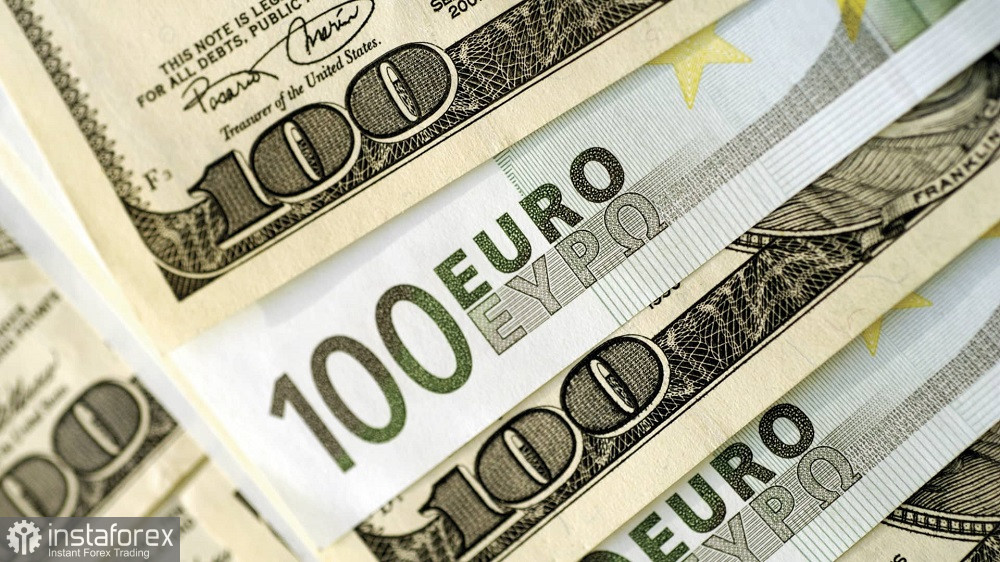The EUR/USD pair managed to settle above 1.09, but as soon as the price approached the borders of 1.10, the buyers preferred to take profit, thereby blowing out the bullish momentum. However, despite this circumstance, the uptrend is still going on as the pair has been consistently growing for six weeks in a row.
Bullish outlook for EUR/USD
The main obstacle for the EUR/USD pair is located at the 1.0980 level which corresponds to the upper line of the Bollinger Bands indicator on the daily and weekly charts. If EUR/USD buyers overcome this barrier, they will open up their way to the 1.1000 area, thereby confirming the strength of the bullish movement. The fundamental background favors the development of this scenario.

The divergence in expectations of further policy moves of the Federal Reserve and the ECB continues to work in favor of the euro. A few months ago, this factor was supporting the greenback, but the situation has changed dramatically since then. The European Central Bank remains one of the few hawks among influential central banks along with the Reserve Bank of New Zealand, while the Federal Reserve is gradually shifting towards the wait-and-see approach. Many experts still doubt that the Fed will decide on another 25 basis point rate hike this year at the policy meeting in May. According to the CME Group FedWatch Tool, the chance of a 25 basis point rate hike in May has dropped to 42% from almost 60% yesterday morning.
Hawkish expectations weakened after the publication of a series of macroeconomic indicators. First and foremost, the ISM Manufacturing Index disappointed investors. The index plummeted to a nearly two-year low of 46.3 points. Another indicator also ended up in the red zone: the volume of expenditures in the construction sector. The indicator came in at -0.1% after growing by 0.4% in the previous month.
Preliminary data on the labor market also discouraged traders. The US Bureau of Labor Statistics reported that the number of job vacancies in February was 9.9 million compared to 10.5 million in January. The figure was worse than expected. According to the consensus, the indicator was supposed to come in at 10.4 million. This report indicates that the labor market is cooling down. The likelihood of a rate hike by the Federal Reserve at the May meeting has decreased again.
Let me remind you that the key labor market data will be published in the United States on Friday, April 7. If the nonfarm payrolls also come in weaker than projected, hawkish expectations for the Federal Reserve's future policy moves will weaken even more. This fact will put additional pressure on the greenback. According to flash estimates, the nonfarm payrolls are expected to log an uptick in the unemployment rate in March to 3.7% and a slowdown in wage growth. The annual rate should come in at 4.3%, which is the weakest pace of growth since September 2021. If the actual readings come in at least at the forecasted levels (if not in the "red zone"), the greenback may be hit by a wave of selling.
ECB acts as EUR's ally
The Federal Reserve is facing a dilemma: to maintain the status quo or to raise the interest rate by 25 basis points. At the same time, the European Central Bank sticks to its assertive stance, not ruling out an immediate half-percent rate hike next month.
Such prospects put the euro in a privileged position. Over time, this differential will only intensify. This is especially true if core inflation in the eurozone continues to climb, setting new historical records.
I would like to remind you that the main inflation indicators such as Consumer Price Index, Producer Price Index, and Core PCE Index confirm a slowdown in inflation in the United States. Yes, the pace of decline could be more active. Nevertheless, easing inflationary pressure is visible to the naked eye. On the other hand, European inflation shows a contradictory dynamic: the headline Consumer Price Index consistently declines, primarily due to lower energy prices, while the core CPI steadily grows.
Therefore, the market increasingly speculates that the Federal Reserve will take a break next month, but the ECB will raise interest rates by 50 basis points at a time. By the way, European Central Bank representative Robert Holzmann, the Governor of the Austrian Central Bank, expanded on the 50-point scenario the day before yesterday, lamenting the stubborn growth of core inflation in the eurozone.
Conclusions
By and large, the greenback is currently reaping the fruits of the Fed's March meeting when the regulator signaled a shift towards the dovish rhetoric. The Federal Reserve indicated that revising the agenda for monetary policy, it would "take into account the cumulative tightening of monetary policy, the lagged effects of monetary policy as well as inflation, economic, and financial developments." Therefore, each more or less significant macroeconomic report in the "red zone" now puts downward pressure on the US dollar. The euro, in turn, benefits from support from the ECB whose representatives continue to deliver hawkish messages.
From a technical standpoint, the EUR/USD pair is positioned between the middle and upper lines of the Bollinger Bands indicator on the daily chart, as well as above all the Ichimoku indicator lines, including the Kumo cloud, which formed a bullish signal. This configuration of indicators suggests a priority for long positions. The nearest and main bullish target is set at the 1.0980 level which corresponds to the upper Bollinger Band on the daily timeframe.





















